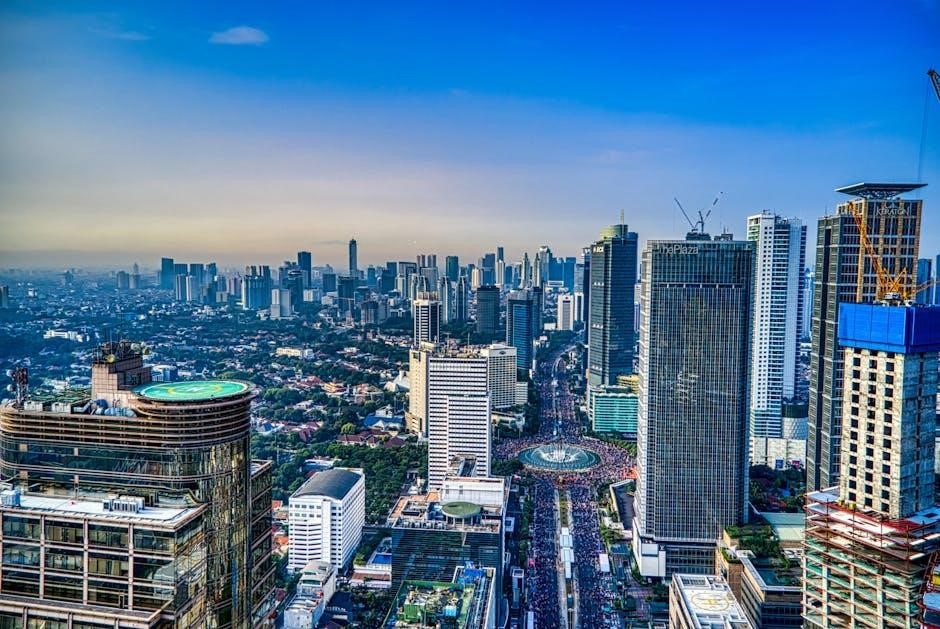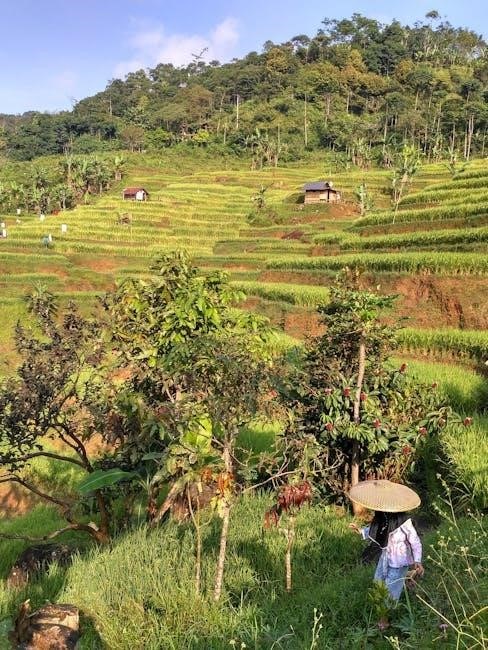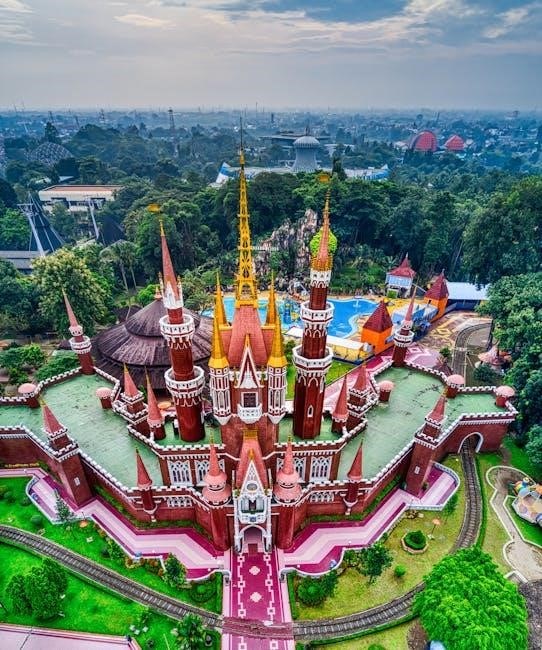The Jakarta Method refers to the 1960s mass killings in Indonesia, backed by the CIA, targeting communists. This Cold War strategy shaped global politics and authoritarian regimes.
1.1 Overview of the Jakarta Method
The Jakarta Method refers to the systematic mass killings and repression carried out in Indonesia during the 1965-66 period; It involved the execution of approximately one million accused communists, with significant support from the CIA. This strategy was part of the U.S.-led anticommunist crusade during the Cold War, aiming to suppress leftist movements globally. The method served as a blueprint for similar operations in Latin America and other regions. Vincent Bevins’ book, The Jakarta Method, highlights how this violent campaign shaped the modern world, demonstrating the far-reaching consequences of U.S. intervention and the installation of authoritarian regimes. The term underscores the brutal efficiency of state-sponsored violence in achieving geopolitical goals.
1.2 Historical Context of the 1965-66 Mass Killings in Indonesia
The 1965-66 mass killings in Indonesia occurred amid a volatile political climate. Following a failed coup, the Indonesian military, led by General Suharto, launched a campaign against the Communist Party of Indonesia (PKI). This purge, supported by the CIA, resulted in the deaths of over one million people. The U.S. provided logistical and intelligence support, viewing the PKI as a threat to its Cold War interests. The killings marked a turning point, consolidating Suharto’s dictatorship and aligning Indonesia with Western powers. This dark chapter remains a critical example of Cold War geopolitics and state-sponsored violence, as detailed in Vincent Bevins’ The Jakarta Method, which sheds light on the global implications of these events.

The Mass Murder Program in Indonesia
The 1965-66 Indonesian mass murder program targeted communists, killing over one million. The CIA-backed campaign eliminated the PKI, enabling the rise of a U.S.-aligned authoritarian regime.

2.1 The Role of the CIA in the Indonesian Massacres
The CIA played a pivotal role in the Indonesian massacres by providing lists of suspected communists to the Indonesian military. This intelligence enabled the systematic targeting and execution of over one million people. The U.S. saw Indonesia as a strategic Cold War asset, fearing communist expansion in Southeast Asia. By supporting the military regime, the CIA ensured the elimination of the Indonesian Communist Party (PKI), aligning the nation with Western interests. The agency’s involvement included logistical support and diplomatic cover, helping to suppress dissent and consolidate authoritarian rule. This intervention set a precedent for covert operations in other regions, shaping global Cold War dynamics.
2.2 The Indonesian Government’s Involvement in the Killings
The Indonesian government, under General Suharto, played a central role in the massacres, framing the killings as a necessary anti-communist purge. The military, with CIA support, systematically targeted suspected communists, leftists, and ethnic Chinese. The government justified the violence as a means to stabilize the nation and prevent communist takeover. This campaign resulted in the deaths of at least one million people, solidifying Suharto’s authoritarian regime. The Indonesian government’s direct involvement in the massacres marked a brutal consolidation of power, with victims often buried in mass graves or thrown into rivers. This state-sponsored violence remains a dark chapter in Indonesia’s history.

The Jakarta Method as a Cold War Strategy
The Jakarta Method exemplified a broader U.S. Cold War strategy to suppress communism globally. It involved supporting authoritarian regimes and anti-communist purges, reshaping political landscapes in Indonesia and beyond.
3.1 The U.S. Anticommunist Crusade During the Cold War
The U.S. anticommunist crusade during the Cold War was a defining strategy to counter Soviet influence. It involved covert operations, propaganda, and military interventions to prevent the spread of communism. In Indonesia, this strategy manifested through the Jakarta Method, where the U.S. supported the Indonesian military in eliminating suspected communists; The CIA provided intelligence and logistical support, enabling the mass killings of over one million people. This campaign was part of a broader effort to install anticommunist regimes globally, particularly in Latin America and Southeast Asia, ensuring U.S. geopolitical dominance. The success of such operations solidified the U.S. position as a global superpower.

3.2 The Impact of the Jakarta Method on Global Politics
The Jakarta Method significantly influenced global politics by setting a precedent for U.S.-backed anticommunist interventions. It demonstrated the effectiveness of covert operations and mass repression in consolidating authoritarian regimes. The method inspired similar strategies in Latin America, where military coups and state-sponsored violence became common tools for suppressing leftist movements. This approach reinforced the Cold War paradigm of ideological containment, shaping international relations and human rights dynamics. The long-term impact includes the normalization of state violence as a means of political control, leaving a legacy of repression and undermining democratic movements worldwide. The Jakarta Method remains a critical case study in understanding the darker aspects of Cold War geopolitics and their enduring consequences.

The Book “The Jakarta Method” by Vincent Bevins
The Jakarta Method, by Vincent Bevins, explores the U.S.-backed anticommunist violence in Indonesia and its global implications, shedding light on Cold War strategies and their legacy.
4.1 Summary of the Book’s Key Arguments

Vincent Bevins’ The Jakarta Method reveals how the U.S. orchestrated anticommunist violence globally, focusing on Indonesia’s 1965-66 massacres. Bevins argues that the CIA-backed killings of over one million alleged communists were a pivotal Cold War strategy, shaping authoritarian regimes worldwide. He examines similar events in Latin America, such as Brazil and Chile, showing how these campaigns were intentionally obscured. The book critiques the U.S. role in crushing leftist movements, using declassified documents and eyewitness testimonies. Bevins contends that these actions were central to Washington’s triumph in the Cold War, yet remain overlooked due to the secrecy of CIA operations. His work underscores the brutal legacy of U.S. foreign policy and its enduring impact on global politics.
4.2 The Author’s Research and Sources
Vincent Bevins’ research for The Jakarta Method is based on extensive archival work, declassified documents, and eyewitness testimonies from twelve countries. He draws on newly released Cold War-era records, revealing the CIA’s role in Indonesia and beyond. Bevins also conducted interviews with survivors of the massacres and analyzed historical archives from Indonesia, Brazil, and the U.S. His work incorporates journalistic investigations and academic studies, providing a comprehensive understanding of the mass murder programs. By synthesizing these sources, Bevins constructs a compelling narrative that links U.S. foreign policy to global atrocities, offering a well-documented critique of Cold War strategies and their lasting impact.

The Global Implications of the Jakarta Method
The Jakarta Method inspired similar anti-communist campaigns in Latin America and beyond, showcasing the U.S. strategy to suppress left-wing movements globally through covert operations and violence.
5.1 Similar Events in Latin America and Beyond
The Jakarta Method inspired similar anti-communist campaigns globally, particularly in Latin America. In Brazil, the 1964 military coup, backed by the U.S., mirrored Indonesia’s strategy, targeting leftists and intellectuals. Similarly, Chile’s 1973 coup against Salvador Allende followed a comparable pattern, with covert U.S. support. These events highlight how the Jakarta Method became a blueprint for suppressing leftist movements worldwide. The CIA’s involvement in these regions demonstrates a consistent strategy of using violence and authoritarian regimes to maintain U.S. influence during the Cold War. Such interventions left lasting legacies of political repression and human rights abuses, reshaping global politics and fostering authoritarianism. The parallels between these events underscore the far-reaching impact of the Jakarta Method.
5.2 The Legacy of U.S.-Backed Mass Murder Programs
The Jakarta Method and similar U.S.-backed campaigns left a lasting legacy of political repression and human rights abuses. These interventions entrenched authoritarian regimes, suppressed civil liberties, and eliminated leftist movements globally. The strategy of using mass murder as a tool for geopolitical control set a dangerous precedent, enabling future interventions. The suppression of dissent and the installation of puppet governments became hallmarks of Cold War-era foreign policy. This legacy continues to influence modern geopolitics, with authoritarianism and state-sponsored violence remaining pervasive in many regions. The Jakarta Method serves as a stark reminder of the consequences of imperialism and the enduring impact of covert operations on global stability and justice.
The Role of the United States in Shaping the Cold War World
The U.S. shaped the Cold War world by supporting Indonesia’s mass killings via the Jakarta Method, installing puppet states, and suppressing leftist movements globally.
6.1 The Strategy of Installing Puppet States
The U.S. employed the Jakarta Method to install puppet states, ensuring alignment with its Cold War goals. This involved backing authoritarian regimes, such as Indonesia’s post-1965 government, to suppress communism. By supporting military coups and mass killings, the U.S. strategically eliminated leftist movements, securing geopolitical influence. Indonesia became a key example, where the CIA assisted in the extermination of communists, leading to a pro-American regime. This strategy replicated in Latin America, solidifying U.S. dominance and shaping modern geopolitics.
6.2 The Influence of the Jakarta Method on Modern Geopolitics
The Jakarta Method set a chilling precedent for modern geopolitics, demonstrating how state-sanctioned violence and U.S.-backed interventions could reshape global power structures. Its legacy is evident in the rise of authoritarian regimes and the suppression of leftist movements worldwide. The strategy of using mass murder to install puppet states has inspired similar tactics in other regions, reinforcing U.S. dominance during the Cold War. Today, the Jakarta Method serves as a cautionary tale, highlighting the long-term consequences of covert interventions and the erosion of civil liberties. Vincent Bevins’ book sheds light on these dynamics, urging a critical examination of historical and contemporary geopolitical strategies.
The PDF Availability and Online Resources
The Jakarta Method PDF is available online through various platforms, offering insights into the U.S.-backed mass killings in Indonesia and their global implications. Access the document for a deeper understanding of this critical Cold War strategy and its lasting impact on international relations. Ensure to respect copyright laws when sharing or downloading the material.
7.1 How to Access “The Jakarta Method” in PDF Format

The Jakarta Method PDF can be accessed through various online platforms, including academic databases, bookstores, and file-sharing sites. Readers can purchase or download the PDF from retailers like Amazon or directly from the publisher’s website. Additionally, some libraries offer digital copies for borrowing. Ensure to respect copyright laws when accessing or sharing the document. The PDF provides a comprehensive overview of the U.S.-backed mass killings in Indonesia and their global implications, making it a crucial resource for understanding Cold War strategies and their lasting impact on international relations.
7.2 Key Takeaways from the Document

The Jakarta Method PDF reveals the U.S.-backed mass murder of over one million Indonesians accused of communism in the 1960s. It exposes the CIA’s role in supporting authoritarian regimes and the global spread of anticommunist violence. The document highlights how this strategy shaped Cold War geopolitics, influencing events in Latin America and beyond. Vincent Bevins’ research underscores the long-lasting impact of these events on modern authoritarianism and the suppression of political dissent. The PDF serves as a critical resource for understanding the darker side of U.S. foreign policy and its legacy in shaping global power dynamics.